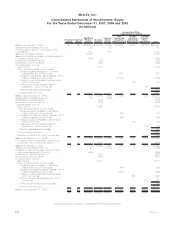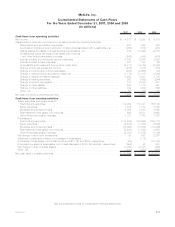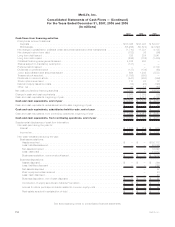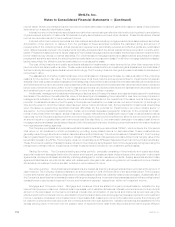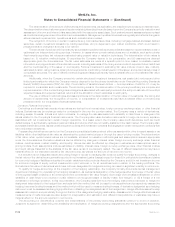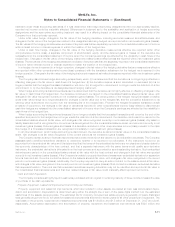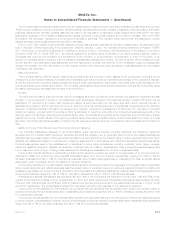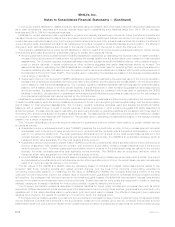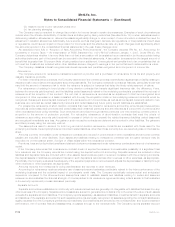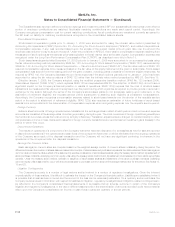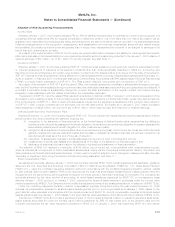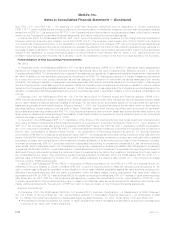MetLife 2007 Annual Report Download - page 109
Download and view the complete annual report
Please find page 109 of the 2007 MetLife annual report below. You can navigate through the pages in the report by either clicking on the pages listed below, or by using the keyword search tool below to find specific information within the annual report.The Company also reviews periodically other long-term assumptions underlying the projections of estimated gross margins and profits.
These include investment returns, policyholder dividend scales, interest crediting rates, mortality, persistency, and expenses to administer
business. Management annually updates assumptions used in the calculation of estimated gross margins and profits which may have
significantly changed. If the update of assumptions causes expected future gross margins and profits to increase, DAC and VOBA
amortization will decrease, resulting in a current period increase to earnings. The opposite result occurs when the assumption update
causes expected future gross margins and profits to decrease.
Prior to 2007, DAC related to any internally replaced contract was generally expensed at the date of replacement. As described more
fully in “Adoption of New Accounting Pronouncements”, effective January 1, 2007, the Company adopted Statement of Position (“SOP”)
05-1, Accounting by Insurance Enterprises for Deferred Acquisition Costs in Connection with Modifications or Exchanges of Insurance
Contracts (“SOP 05-1”). Under SOP 05-1, an internal replacement is defined as a modification in product benefits, features, rights or
coverages that occur by the exchange of a contract for a new contract, or by amendment, endorsement, or rider to a contract, or by
election or coverage within a contract. If the modification substantially changes the contract, the DAC is written off immediately through
income and any new deferrable costs associated with the replacement contract are deferred. If the modification does not substantially
change the contract, the DAC amortization on the original contract will continue and any acquisition costs associated with the related
modification are expensed.
Sales Inducements
The Company has two different types of sales inducements which are included in other assets: (i) the policyholder receives a bonus
whereby the policyholder’s initial account balance is increased by an amount equal to a specified percentage of the customer’s deposit;
and (ii) the policyholder receives a higher interest rate using a dollar cost averaging method than would have been received based on the
normal general account interest rate credited. The Company defers sales inducements and amortizes them over the life of the policy using
thesamemethodologyandassumptionsusedtoamortizeDAC.
Goodwill
Goodwill is the excess of cost over the fair value of net assets acquired. Goodwill is not amortized but is tested for impairment at least
annually or more frequently if events or circumstances, such as adverse changes in the business climate, indicate that there may be
justification for conducting an interim test. Impairment testing is performed using the fair value approach, which requires the use of
estimates and judgment, at the “reporting unit” level. A reporting unit is the operating segment or a business one level below the operating
segment, if discrete financial information is prepared and regularly reviewed by management at that level. For purposes of goodwill
impairment testing, goodwill within Corporate & Other is allocated to reporting units within the Company’s business segments. If the
carrying value of a reporting unit’s goodwill exceeds its fair value, the excess is recognized as an impairment and recorded as a charge
against net income. The fair values of the reporting units are determined using a market multiple, a discounted cash flow model, or a cost
approach. The critical estimates necessary in determining fair value are projected earnings, comparative market multiples and the discount
rate.
Liability for Future Policy Benefits and Policyholder Account Balances
The Company establishes liabilities for amounts payable under insurance policies, including traditional life insurance, traditional
annuities and non-medical health insurance. Generally, amounts are payable over an extended period of time and related liabilities are
calculated as the present value of future expected benefits to be paid reduced by the present value of future expected premiums. Such
liabilities are established based on methods and underlying assumptions in accordance with GAAP and applicable actuarial standards.
Principal assumptions used in the establishment of liabilities for future policy benefits are mortality, morbidity, policy lapse, renewal,
retirement, disability incidence, disability terminations, investment returns, inflation, expenses and other contingent events as appropriate
to the respective product type. Utilizing these assumptions, liabilities are established on a block of business basis.
Future policy benefit liabilities for participating traditional life insurance policies are equal to the aggregate of (i) net level premium
reserves for death and endowment policy benefits (calculated based upon the non-forfeiture interest rate, ranging from 3% to 10% for
domestic business and 3% to 10% for international business, and mortality rates guaranteed in calculating the cash surrender values
described in such contracts); and (ii) the liability for terminal dividends.
Future policy benefits for non-participating traditional life insurance policies are equal to the aggregate of the present value of expected
future benefit payments and related expenses less the present value of expected future net premiums. Assumptions as to mortality and
persistency are based upon the Company’s experience when the basis of the liability is established. Interest rates for the aggregate future
policy benefit liabilities range from 3% to 10% for domestic business and 3% to 12% for international business.
Participating business represented approximately 9% and 10% of the Company’s life insurance in-force, and 33% and 38% of the
number of life insurance policies in-force, at December 31, 2007 and 2006, respectively. Participating policies represented approximately
31% and 30%, 30% and 29%, and 31% and 30% of gross and net life insurance premiums for the years ended December 31, 2007, 2006
and 2005, respectively. The percentages indicated are calculated excluding the business of the reinsurance segment.
Future policy benefit liabilities for individual and group traditional fixed annuities after annuitization are equal to the present value of
expected future payments. Interest rates used in establishing such liabilities range from 3% to 11% for domestic business and 4% to 10%
for international business.
Future policy benefit liabilities for non-medical health insurance are calculated using the net level premium method and assumptions as
to future morbidity, withdrawals and interest, which provide a margin for adverse deviation. Interest rates used in establishing such liabilities
range from 3% to 7% for domestic business and 3% to 10% for international business.
F-13MetLife, Inc.
MetLife, Inc.
Notes to Consolidated Financial Statements — (Continued)



